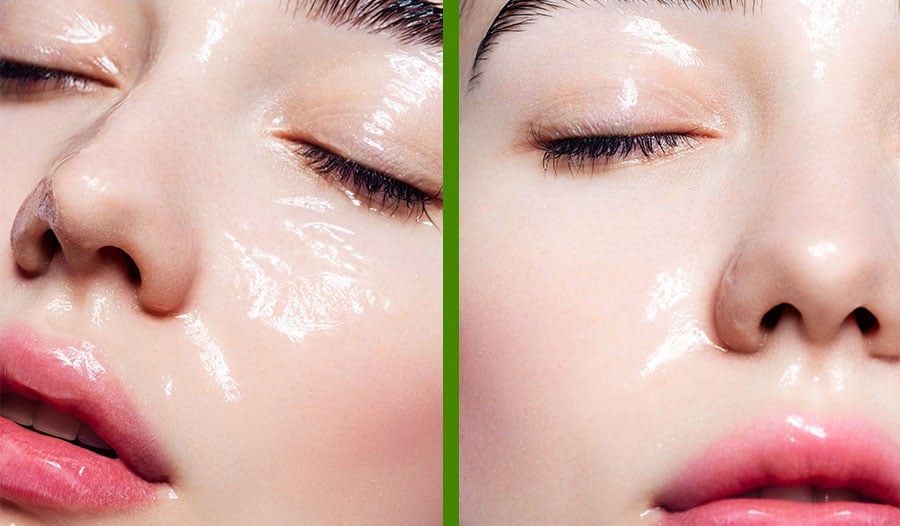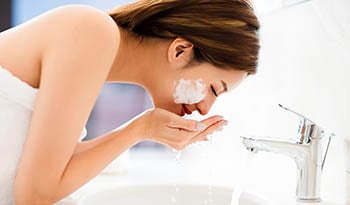Slugging Skincare and Tips You Need Right Now
DISCLAIMER:This blog does not intend to provide diagnosis...
- In this article:
- How Does Slugging Improve Your Skin?
- Is Slugging Good for Your Skin?
- How Often Should You Slug?
- 7 Slugging Skincare Tips You Need Right Now
- Go Forth And Slug On

Winter brings cold dry air that can lead to red, irritated, and dry skin. Everyone looks for the best moisturizers to address dry skin but there is a fundamental skincare hack that may be the game changer you are looking for. The skincare trend that is touted to solve all dry skin problems is called “slugging.” While it’s been trending on social media, it isn’t a new concept, and the technique has been used for many years. Some believe that it originated in South Korea.
The concept is simple: Apply a petroleum-based product like Vaseline or Aquaphor as the final step in your skincare routine in order to trap in moisture and create a seal that promotes healing the skin barrier. But … Why is it called “slugging”? Well, that’s because after applying a petroleum-based product to your skin, it looks shiny, like … the trail left by a slug. I know that doesn’t sound appealing! But this is a dermatologist-approved hack that can dramatically improve the overall appearance and condition of your skin.
How Does Slugging Improve Your Skin?
The thought of applying a product such as Vaseline all over your face—or any part of your body—doesn’t sound appealing. But hear me out. For years, it’s been used to moisturize baby skin, aid in healing wounds, and relieve chapped lips. Those are just a few ways that petroleum-based products are used in skincare. Experts suggest applying a thin layer of petroleum jelly to seal in moisture and promote healing, especially when the skin barrier has been compromised. This can happen due to over-exfoliation, skincare treatments like lasers and micro-needling, dry weather, genetics, or skin conditions such as eczema and psoriasis.
To maintain a healthy skin barrier, the skin cells and lipids must be in balance. As lipids are lost, your skin loses hydration leading to dehydrated and dry skin. A petroleum layer protects the skin and prevents dehydration. The goal is not to prevent all-natural water loss but rather most. By allowing some water loss to still occur, your skin continues to produce new lipids to repair itself. For this reason, petroleum is highly recommended. It prevents most water loss, but not 100% of it. Think of it as continuing to allow your skin to breathe.
Is Slugging Good for Your Skin?
Despite what you may have heard, petroleum jelly is safe for use on your skin. The American Academy of Dermatology recommends petroleum jelly for numerous uses in skincare, including applying it to your eyelids and on your baby’s skin.
Petroleum jelly products to consider for slugging include Vaseline, Aquaphor, and Pond’s Face Moisturizer. (In the United States, products with more than 30% petroleum are regulated by the FDA and must be registered on the National Drug Codes List.)
Concerns about the purity of the product should be eased when you take into consideration petroleum is considered a skincare drug. Since it’s monitored by the FDA, the factory and techniques used to manufacture the product must follow best practices. This offers consumers in the United States reassurance that the products are pure and designated as safe for the intended use. Having said all this, it’s still important that you check with your dermatologist or medical provider to ensure that slugging is something you should incorporate into your skincare routine.
If you still feel uncomfortable with using a petroleum-based product, Pipette Baby Balm mimics petroleum but is entirely plant-based, and free of petroleum. Other good options are products that promote skin barrier repair such as ceramide creams and products containing squalene.
How Often Should You Slug?
This is difficult to answer because everyone’s skin is different. If your skin is prone to being dry and flakey, you could incorporate slugging into your nightly skincare routine. Others may find that their skin fluctuates, and it’s only dry during the winter months or following sunburn or some other unique event. If that’s the case, slugging is something you can do as needed. Simply listen to your skin.
If your skin is extremely oily or acne-prone, slugging may not be the ideal solution for you. This is something you can confirm with your dermatologist. While it may feel like petroleum jelly is greasy and would cause clogged pores, it doesn’t. The molecules are too large to be absorbed by your skin. However, if your skin is oily, slugging may lead to irritated hair follicles because enough oil cannot escape.
In that instance, you’ll want to look for a product that is less occlusive than petroleum jelly, such as Cetaphil Intensive Healing Lotion with Ceramides or Derma E Ultra Hydrating Advanced Night Cream.
Both products are good alternatives for acne-prone skin because they will still promote skin repair and allow more oil to escape, helping to avoid irritation that may lead to a breakout.
7 Slugging Skincare Tips You Need Right Now
1. Slugging should be done as part of your bedtime skincare routine
The magic happens when you sleep. This is when your body works the hardest to repair and heal itself. Slugging should be incorporated as part of your nighttime skincare routine. If you don’t sleep on your back, your sheets and pillowcase may get some product on them, but the results will be worth it. To help keep things a bit less messy, after applying the petroleum during your nightly skincare routine, let it sit for 15 minutes before getting into bed.
2. Cleanse your skin
Use a gentle but effective cleanser to clean your skin and remove all impurities before slugging. If your skin is dry and irritated, do not use an exfoliating cleanser.
Your best option is something hydrating for your skin such as Banila Co. Clean It Zero (Nourishing) or Radiant Seoul Hydrating Bubble Cleansing Oil.
Since slugging creates a seal on your skin, makeup and sunscreen trapped under the occlusive layer may promote a breakout. Be sure you’ve thoroughly cleansed and rinsed your skin on the night you plan to slug.
3. Hydrate and moisturize your skin
Before slugging your skin, it’s important to hydrate and moisturize. The slugging process is going to seal in the moisture, so choose products that are hydrating and nourishing. Hyaluronic acid serum may be applied before a moisturizer and will attract water to intensely hydrate your skin. Hyaluronic acid and other humectants work best when applied to damp skin.
Following an intensely hydrating serum, use a nourishing daily moisturizer. A fan favorite moisturizer to consider is Eucerin Q10 Anti-Wrinkle Cream.
Another option that is a great pick for sensitive skin is Neutrogena Hydro Boost Gel Cream. Moisturizers that contain hyaluronic acid, such as the Neutrogena option are ideal for extra hydration. Prior to applying moisturizer, you can use a hydrating sheet mask to further boost hydration.
4. Seal your skin
Now, the part you’ve been waiting for. Apply a thin occlusive layer of a petroleum-based product to seal in the moisture and promote skin repair.
The most basic and affordable option is Vaseline. Vaseline is pure white petroleum jelly, and you can’t go wrong with this option.
Another great choice—and my personal favorite—that is often recommended by dermatologists is Aquaphor.
5. Skip the retinoids
On a night you plan to slug your skin, skip applying retinoids and products with AHA and BHA acids. Applying an occlusive product layer to your skin in combination with AHA and BHA acids or retinoids may result in irritation as the occlusive layer may increase penetration of these products on your skin. If you are a retinoid user and your skin is irritated from the use of retinoids, especially if it’s something you recently introduced into your routine, slugging should provide some relief to the redness and irritation you may experience when first starting to use a retinoid.
6. Slugging is not just for your face
Slugging can be used on any area of skin where you experience dryness and irritation. If your heels are cracked and dry and need some extra love, you can cleanse and moisturize them and apply a petroleum layer on the top and bottom of your feet. To avoid making a mess, consider a reusable set of gel heel socks to keep the product on your feet. Other areas of the body that you may consider for slugging are elbows, hands, and knees.
Vaseline Intensive Care Advanced Body Repair Lotion is an excellent choice for an all-over body moisturizer, and thin cotton gloves can be worn all night to keep the petroleum jelly on your hands and off your bedsheets.
7. Wash your bedding regularly
Whether you are slugging or not, wash your bedding regularly. Dust and debris will collect on your sheets even if you aren’t using them. While you can’t see dead skin cells on your pillow and bedsheets, your body sheds skin cells while you sleep. A mild unscented detergent is best to use for all skin types. Also, if you aren’t using a silk or satin pillowcase, it will help reduce friction on your hair and skin.
Go Forth And Slug On
Now you have all the knowledge in hand to introduce this into your skincare routine! The focus of slugging is strengthening and repairing the skin barrier. There’s no harm in that. If you’re wondering, most petroleum jelly produced these days is vegan. But if you have environmental concerns, there are other options to achieve the same result. I can’t think of anyone who isn’t after plump and dewy morning skin, so give this a try and see what you think!

 By Janine Hill
By Janine Hill


